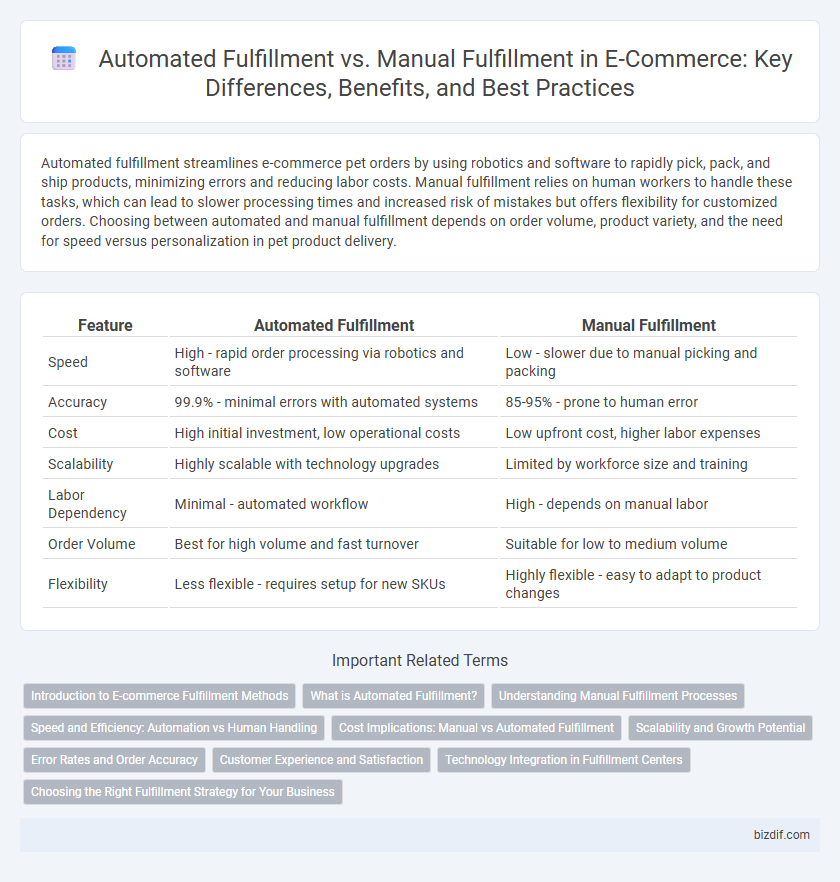Automated fulfillment streamlines e-commerce pet orders by using robotics and software to rapidly pick, pack, and ship products, minimizing errors and reducing labor costs. Manual fulfillment relies on human workers to handle these tasks, which can lead to slower processing times and increased risk of mistakes but offers flexibility for customized orders. Choosing between automated and manual fulfillment depends on order volume, product variety, and the need for speed versus personalization in pet product delivery.
Table of Comparison
| Feature | Automated Fulfillment | Manual Fulfillment |
|---|---|---|
| Speed | High - rapid order processing via robotics and software | Low - slower due to manual picking and packing |
| Accuracy | 99.9% - minimal errors with automated systems | 85-95% - prone to human error |
| Cost | High initial investment, low operational costs | Low upfront cost, higher labor expenses |
| Scalability | Highly scalable with technology upgrades | Limited by workforce size and training |
| Labor Dependency | Minimal - automated workflow | High - depends on manual labor |
| Order Volume | Best for high volume and fast turnover | Suitable for low to medium volume |
| Flexibility | Less flexible - requires setup for new SKUs | Highly flexible - easy to adapt to product changes |
Introduction to E-commerce Fulfillment Methods
E-commerce fulfillment methods include automated and manual fulfillment, each offering distinct advantages for order processing efficiency and accuracy. Automated fulfillment leverages robotics, software, and AI to streamline inventory management, picking, packing, and shipping, significantly reducing human error and delivery times. Manual fulfillment relies on human workers for order handling, providing flexibility for customized orders but often resulting in slower processing and higher labor costs.
What is Automated Fulfillment?
Automated fulfillment refers to the use of technology-driven systems, such as robotics, conveyor belts, and warehouse management software, to streamline order processing and inventory handling in e-commerce operations. This method enhances accuracy, reduces labor costs, and accelerates shipping times compared to manual fulfillment processes. Integrating automated fulfillment solutions leads to improved scalability and customer satisfaction by minimizing errors and optimizing supply chain efficiency.
Understanding Manual Fulfillment Processes
Manual fulfillment processes involve human workers picking, packing, and shipping orders, which can lead to higher error rates and slower turnaround times compared to automated systems. Inventory management relies heavily on manual stock checks and paper-based documentation, increasing the risk of discrepancies and delays. Efficient manual operations require well-trained staff and clear workflow protocols to mitigate human errors and maintain customer satisfaction in e-commerce environments.
Speed and Efficiency: Automation vs Human Handling
Automated fulfillment systems process orders significantly faster than manual handling by utilizing robotics and real-time data integration, reducing order cycle times by up to 70%. Machine learning algorithms optimize picking routes and inventory management, minimizing errors and enhancing throughput efficiency. In contrast, manual fulfillment relies heavily on human labor, which increases processing times and error rates, ultimately limiting scalability for high-volume e-commerce operations.
Cost Implications: Manual vs Automated Fulfillment
Automated fulfillment significantly reduces labor costs by utilizing robotics and AI-driven systems to handle order processing, packaging, and inventory management. Manual fulfillment incurs higher expenses due to the need for extensive human labor, increased error rates, and slower processing times, which can lead to costly delays. Investing in automated solutions enhances scalability and lowers long-term operational costs, driving greater efficiency in e-commerce logistics.
Scalability and Growth Potential
Automated fulfillment systems enable e-commerce businesses to scale efficiently by processing a higher volume of orders with greater speed and accuracy compared to manual fulfillment. The growth potential of automated fulfillment lies in its ability to integrate with inventory management and real-time data analytics, reducing labor costs and minimizing errors during peak demand. Manual fulfillment struggles with scalability due to human limitations, slower processing times, and increased risk of mistakes, hindering e-commerce businesses from meeting rapid growth demands.
Error Rates and Order Accuracy
Automated fulfillment systems significantly reduce error rates by utilizing barcode scanning, real-time inventory tracking, and robotic handling, which enhance overall order accuracy. Manual fulfillment often suffers from human errors such as picking mistakes and mislabeling, leading to higher return rates and customer dissatisfaction. E-commerce businesses adopting automation consistently report improved order accuracy above 99%, minimizing operational costs and boosting customer loyalty.
Customer Experience and Satisfaction
Automated fulfillment enhances customer experience by accelerating order processing times and minimizing errors, leading to timely and accurate deliveries. Manual fulfillment often suffers from slower handling and higher risks of mistakes, resulting in delayed shipments and increased customer frustration. Prioritizing automation in e-commerce fulfillment improves overall customer satisfaction by ensuring reliable, fast service and consistent order accuracy.
Technology Integration in Fulfillment Centers
Automated fulfillment systems leverage robotics, AI, and real-time inventory management software to significantly reduce processing times and errors compared to manual fulfillment methods. Integration of technologies such as conveyor belts, automated guided vehicles (AGVs), and warehouse management systems (WMS) enhances operational efficiency and scalability in fulfillment centers. This technological synergy enables higher order accuracy, faster shipping, and cost savings, positioning automated fulfillment as a critical innovation in modern e-commerce logistics.
Choosing the Right Fulfillment Strategy for Your Business
Automated fulfillment leverages robotics and software to streamline order processing, reduce errors, and scale operations efficiently, making it ideal for high-volume e-commerce businesses seeking speed and accuracy. Manual fulfillment relies on human labor for picking, packing, and shipping, offering flexibility and lower upfront costs, suitable for small businesses with varied product lines or lower order volumes. Evaluating order volume, product complexity, and budget constraints helps determine whether an automated system or manual process aligns best with your e-commerce growth objectives.
Automated Fulfillment vs Manual Fulfillment Infographic

 bizdif.com
bizdif.com